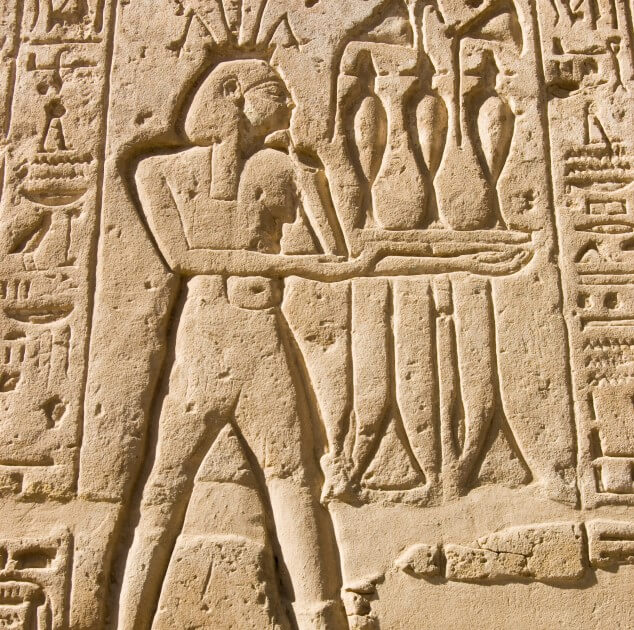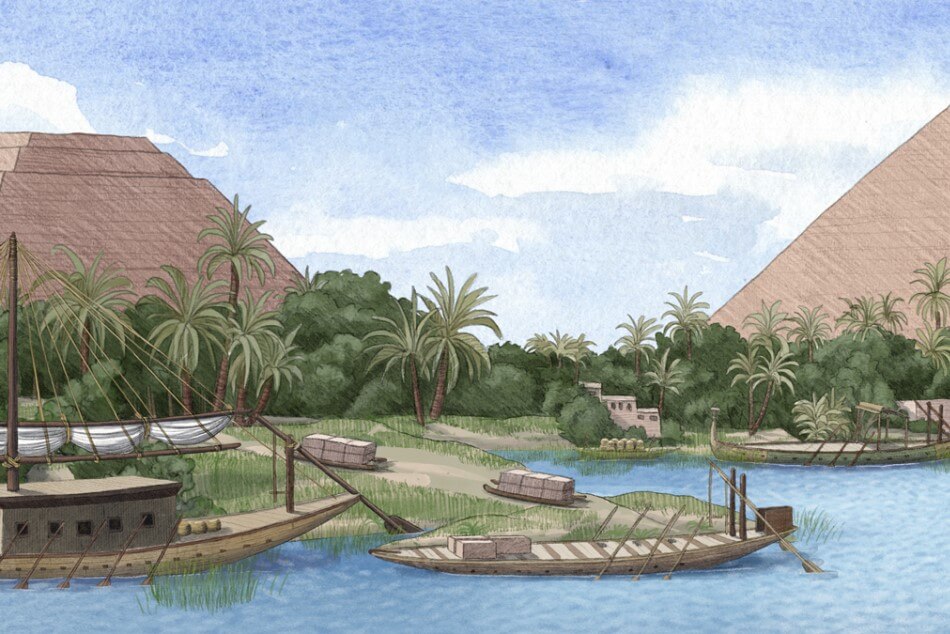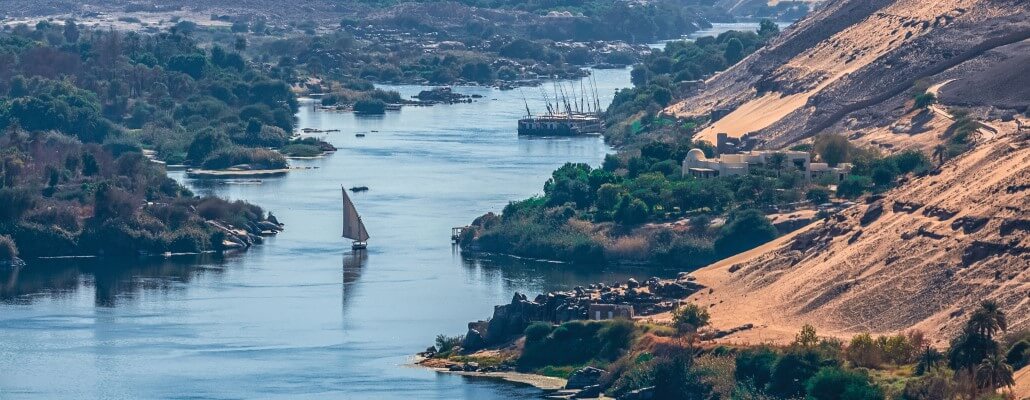Explore Ancient Egypt
- Ancient Egypt Facts
- Ancient Egypt Timeline
- Hieroglyphics
- Egyptian Gods & Goddesses
- Pharaohs
- Notable People (Cleopatra etc.)
- The Nile
- Pyramids
- Mummies
- Inventions & Technology
- Food
It’s not a stretch to say that the Nile river was the catalyst that sparked the ancient Egyptian civilization!
The Nile managed to sweep across the bleak Sahara desert, bringing with it water and rich soil and encouraging ancient Egyptians to settle on its banks and lay the foundations of their timeless civilization.
The role of the Nile wasn’t just limited to agriculture. In fact, it touched every aspect of the Egyptians’ lives. And many of the grandiose architectural marvels wouldn’t have been possible without the Nile’s critical role in transporting materials.
Follow along as we explore some mind-blowing Nile river facts for kids (and adults)!
1. The Nile holds a great religious significance.
Ancient Egyptians were obsessed with the different physical elements that shaped their everyday lives. For this reason, they designated different gods to honor the greater-than-life significance of such elements. Sobek was dubbed the “God of the Nile” and took the form of a man with a crocodile’s head. It stood for fertility, medicine, and unexpected death.
But that’s not all! Another ancient Egyptian god had strong ties with the Nile: Hapi, who represented fertility, was believed to be in charge of the floods. So, the Egyptians looked at the natural phenomenon around them through a religious lens and the Nile held a holy spot. No one could dare misuse or pollute the Nile!
2. The Nile River helped ancient Egyptians create their calendar.
By anticipating the flood season with all the riches it brings, the ancient Egyptians divided their calendar into three different seasons, each lasting for four months.
The first season represented the flood period, where the river brought fertile dirt and laid it across its banks. It’s then followed by the growing season, where farmers tend to their crops and lay down the seeds that will be headed in the upcoming harvest season.
3. The Nile River represented the passageway between life and death.
In addition to its direct link with a number of gods in the Egyptian pantheon, the Nile was considered a spiritual passageway between actual life and death!
Such a belief incentivized ancient Egyptians to build all their tombs on the Nile’s western side. This was driven by the observation of the sunset, as the sun metaphorically dies everyday when it sets to the west!
4. The Nile inspired ancient Egyptians to create a number of water sports.
Competitive sports were a huge deal in ancient Egypt! It’s no coincidence that one of the most popular sports back then was water sparring, which was, you guessed it, played along the river Nile.
The sport is played by teams of two, each with its own canoe. The goal is simple: knock out the other team into the water, and the last team standing (or, more accurately, floating) wins!

5. Ancient Egyptians grew papyrus along the Nile banks.
In addition to documenting their culture and rituals on the temples’ walls, ancient Egyptians used papyrus to create paper. Such manuscripts held up pretty incredibly to our date and helped us learn about the ancient Egyptian civilization timeline.
But it’s not just paper! Papyrus was also used to create boats. The Egyptians couldn’t resist how lightweight papyrus canoes would be, so they went the extra mile to invent a way to maintain a water seal and create papyrus boats.
6. The Nile is the longest river on planet Earth.
With a course spanning 4,132 miles from the great lakes deep in Africa all the way to the Mediterranean sea, the Nile is the longest river on Earth! Along its convoluted course, it crosses 11 different African countries, creating opportunities for trade and strategic relationships between them.
7. The Nile is made up of two tributaries.
Complex water bodies can’t just be traced by a simple line from the origin to the emptying spot, often referred to as a river mouth. That’s especially evident here as the Nile is made up of two tributaries that ensure water keeps flowing all year long.
The first is known as the Blue Nile, and it’s responsible for securing 60% of the Nile’s flow. It’s also worth noting that during the summer season, only the Blue Nile floods. On the other hand, the White Nile retains almost stable levels of water all year long and doesn’t flood during the summer like its Blue brother!
8. The majority of Egypt’s population is centered around the Nile’s delta.
The Nile’s journey across Africa comes to a conclusion at the “delta.” This is where the Nile empties into the Mediterranean sea. Instead of a single river mouth, it spans out into multiple tributaries and creates a rich, fertile region known as the Nile delta.
You might be surprised to know that over 50% of the entire Egyptian population is centered around the delta and its surrounding regions. It’s been like this since ancient times, and despite how far civilization has reached, the Nile remains the magnet that brings Egyptians into its vicinity.
9. If it weren’t for the Nile, there would be no pyramids.

The Nile remains crucial to Egypt’s naval trade lines, and if it weren’t for the ships carrying limestone from south Giza, one of the ancient world’s wonders wouldn’t have been the same. Limestone came from quarries southeast of Giza and had to travel a distance of 6.2 miles till it reached its destination. This was made possible by boats cruising along the Nile.
To Conclude
“Egypt is the gift of the river” is a saying by the ancient Greek historian Herodotus, and it holds up pretty well even after almost 2500 years! The Nile was the cornerstone of the ancient Egyptian civilization and was tightly woven into every aspect of the Egyptians’ daily lives.
It holds a spiritual and religious significance, in addition to its role in facilitating trade and creating secure naval routes. The Nile captured the minds of historians and researchers over the decades, and rightfully so.
Nile River FAQs
How long is the Nile river?
The Nile is the longest river in the world, with a length of 4,130 miles. Some studies argue that the Amazon river is longer, but no concrete evidence yet exists. Because rivers change so often, it’s incredibly hard to accurately measure their length.
How old is the Nile?
While we don’t know for sure, geologists believe that the Nile is at least 30 million years old.
Why is the Nile so special?
The Nile holds great religious significance to ancient Egyptians, and provided them with good fertile soil and water for farming. It was also used to transport materials, including the limestone used to build the pyramids.
Why is the Nile called the Nile?
Nile is derived from the Greek word ‘Neilos’, which means ‘river valley’.
How deep is the Nile?
Although it varies throughout, the depth of the Nile ranges from 26 to 36 feet deep (7.9 t0 10.9 meters).
